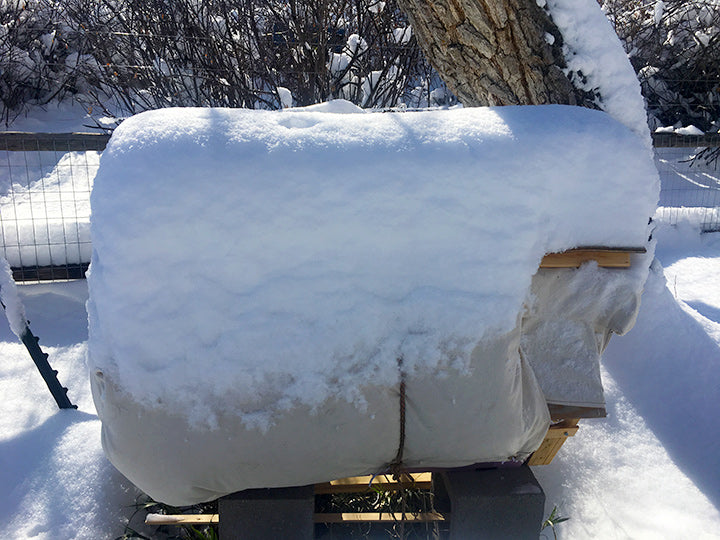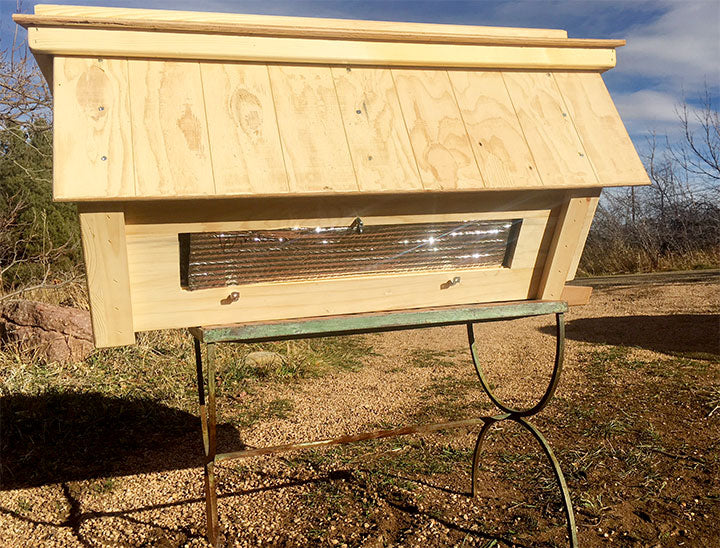The Cathedral Hive® is a much larger volume hive and depending on the nectar flow in your area, the bees may not have filled the hive in the first year. If the hive is only about half full go ahead and insulate at the end of October. Otherwise you could insulate in November. Do watch for extreme fluctuations in temperatures. Winters can bring extreme drops, 70 degrees during the day and in the teens by night. This is extra tough on the bees so be ready to insulate.
Corwin uses both the new Beehive Cozy Cover and Insulation foam board to insulate his Cathedral Hives. If you are in Zone 3, 4, 5, and 6 consider using both as well.

Getting some insulation at the store is easy as there are just a few pieces of insulation to purchase. Before putting on a Cozy Cover, set the foam insulation in place.

The Lower Section 1" insulation board across each Lower Section side

The Lower Section - An easy solution for holding the 1" insulation board in place for the winter. A thin strip of lathe or this yard stick works great!

The Lower Section - Cutting Dimensions for 1" insulation board in place for the winter. 27 1/2" x 9 1/2"
*** Cross reference measurements from your hive
to be sure these numbers work

Silver bubble insulation in the window underneath the Window Cover.

Reflective bubble insulation used in between the window and window cover of the hive.

Put the Window Cover back on the window, over the newly installed bubble insulation.
Upper Section Insulation

The bees will most likely have sealed the vent slots in the top bars with propolis. The bees know best how to regulate their hive so do not cover these slots for them as it may overheat this large volume hive. The bees still need some air flow in the hive.

First cover the vent holes on the Upper Section. Reflective bubble insulation is perfect for this and can be purchased at a home improvement store.

Fill the 4 Upper Section vent holes with insulation

Upper Section - the top of the hive

Cutting Dimensions for 1 1/2" insulation board for underneath the Ventilated Roof

You may have a center brace on top so cut as needed. Use 1-2" thick blue or pink foam insulation to go under the Ventilated Roof of your hive
The Upper Section - between the Roof Siding and the Upper Section of the hive.

Use rigid foam insulation board insulation to slide between the exterior panels and the Upper Section of the hive. This will really help insulate the hive since the bees are hanging on the combs in this Upper Section of the hive.

Rigid foam insulation board, 1/2" thick

Rigid foam insulation board, 1/2" thick
******Again check measurements with your how your hive measures
Now it's time for theBeehive Cozy Cover

Fitting the Cozy Cover on the Cathedral Hivejust use the bungees that come with the Cozy Cover to fit the back of the Cathedral Hive

The back side of the Cathedral Hive with the Cozy Cover
Once the temperatures really drop some optional insulation

In this image you can see that the snow is melting around the exit of the ventilated roof. This is a great sign that the bees are warming the hive and there is still air flow.
Some further insulating can be done once the temperatures are much colder during the day and night. Here in Colorado that is normally in January and February but just watch your local temperatures to be a consistently below 30F

In colder temperatures you can add board insulation in the front and back slots, remember to watch this to not overheat the bees on any days when the temperatures start to warm up, even in the middle of winter.

Rigid Foam Board 1" thick

Rigid foam insulation board, 1" thick

In colder temperatures you can add reflective bubble insulation in the gap between the ventilated roof and hive.
Contact Us for Insulation kits for the Cathedral Hive®







































